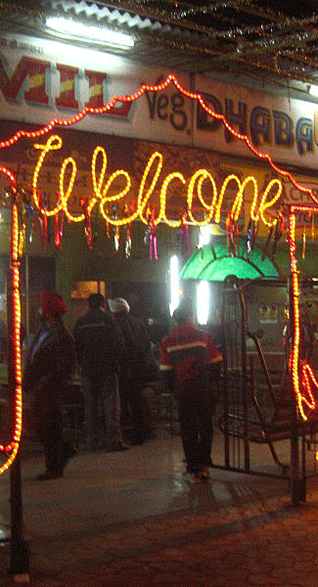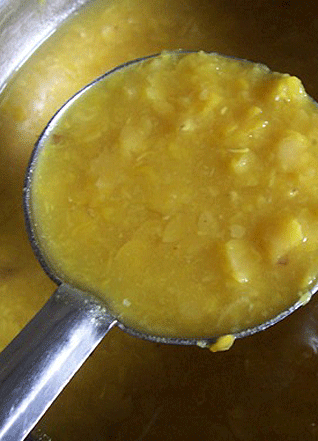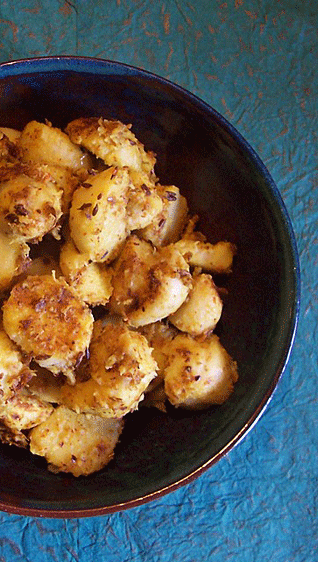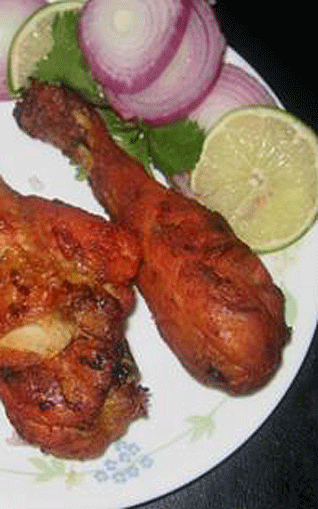Cuisine
The Dhabas of Amritsar
by GUNVANTHI BALARAM
After a kulcha, crunchy with oodles of butter on the outside, attack the gulab jamun instead. Then, try a kebab ... .
In the holy city of Amritsar, nobody can go hungry. For pilgrims and the poor, there's the divine langar at the Golden Temple. For tourists and the locals, as well, there's the ubiquitous dhaba - that hole-in-the-wall eatery that dishes up the most flavoursome and fragrant of food at the humblest of prices.
They are Amritsar's USP - "unique selling proposition" - they have a wide-ranging clientele, from ministers to rickshaw-wallahs.
TASTY, FRESH & CLEAN
Let not its dingy climes lead you astray: the dhaba is the best place to eat at in Amritsar. The food is not just hot and tasty, it's invariably also fresh and clean. Now we know why the Amritsaris quite often prefer to send out for food rather than cook in their own kitchens.
Many certainly desist from cooking breakfast, as Sarabjit Singh will confirm. For the best morning bread is baked on the streets. They just step out and grab a kulcha at the friendly neighbourhood dhaba/kulchewala and wash it down with a glass of frothy lassi or masala chai.
I noticed this everywhere while strolling with my amiable guide through the congested bazaars around the Durbar Sahib. "When I was a boy, many families would leave a basket with a ten paisa or char-anna coin in it, out on the doorstep", he said, as I peered into a roadside tandoor with kulchas stuck all over its stomach.
"And the kulchewala would come around every morning and deposit the required amount of kulche-chole in it". The kids would then "pounce on the fragrant kulche like hungry puppies".
The "Amritsari kulcha" is worth devouring, certainly - it's this plump, yet just that flaky maida roti, soft with potato and onion spiced with pepper, chilly, jeera and anardana on the inside and crunchy with oodles of butter on the outside. Eaten only at breakfast or brunch, it is served with gravied chole (the small chana) and a chutney of tamarind, jaggery and onion, or of tamarind, mint, onion and green chilly.
It's a kulcha that cannot be found anywhere else in the Punjab, not even some miles down the road in Ludhiana. I didn't know any better, but Kiranjot Kaur, the young ex-secretary of the Shiromani Gurdwara Prabhandak Committee (who, along with conservationist Gurmeet Kaur Rai, has initiated measures to have the Golden Temple listed as a World Heritage Site), informed me that the best breakfast places are "All India Fames" (lately corrected to Famous, alas) "Kulcha-Chola Dhaba" on Maqbool Road, "Kanha's" on Lawrence Road and "Kanahya's" at Phullonwala Chowk.
"Don't go away without trying the poori-alu and gur-halwa, it's our traditional Sunday brunch", Kiranjot said emphatically, after I had interviewed her about more material matters at the Golden Temple.
I wasn't about to disobey her.
At Kanahya's, the pooris (of wheat) were light and fluffy; the potatoes, in a sauce of jaggery and tamarind, tangy. The famous kulcha-chole, dished up by the brothers Dalbir and Samarjit Singh for ten rupees, also lived up to its reputation.
Those who bring desi ghee from home for their kulcha get a discount of three rupees, I was told. I didn't see anyone carrying their own homemade ghee, though. When I announced I would prefer mine without butter, the guy fishing them out of the tandoor ignored the request. "Why, having heart trouble?" he asked disdainfully, lashing on the butter.
Ah, well. This is the land of milk and ghee, I'd been warned. "When you get to my hometown, forget all that low-fat rubbish", my Amritsar-raised, Delhi-based artist-friend Nitasha Jaini had warned me before I boarded the Frontier Mail.
"Remember Amritsar is the land of the Sardars, and that the glow on their chubby cheeks comes not with wheatgerm and soya, but with lassi and asli ghee". Never mind that Amritsar has the highest incidence of heart disease in the Punjab.
Nitasha had also instructed me to eat everything I possibly could in the pilgrim town. "Not just Amritsari kulcha and Amritsari fish, but also pakoris, kachauris, jalebis, phirni, kulfi, ma-ki-dal, the prasad at the Harmandir Sahib, the works".
BUTTERY, SPICY & HOT
Playing glutton was easy.
I munched on kachauris on the thirty-minute ride to the Wagah border. Crisp and spicy. The patriotic slogans were still ringing in my ears when I returned for the stuffed parathas and the ma-ki-dal at the "1917 Bharawan da Dhaba" near the Town Hall.
The mooli paratha is guaranteed to satisfy, but the dal is too buttery. I sampled more of the same at a pokey little shop in Jalianwala Bagh. That was better: more spicy, less buttery. And cheap, at Rs. 5 a bowl.
The elderly widower, Jagjit Singh Ahluwalia, keeps the dal on the boil all afternoon long, stirring it now and then. When somebody asks for it, he dishes up some, seasons it with butter, and hands it out: dark, hot, delicious. Perfect with dry tandoori roti and a juicy green chilly.
Skipping its famous thali, I sampled the mithai at the "1916 Kesar da Dhaba", tucked away in the intestine of an old bazaar. The rasmala - marble-sized golis in mellow malai - and gajjar da halwa were divine. So was the phirni - silvery and feather light on the tongue. I saw a Sardar from the diaspora (accent loud and clear) cheerfully having helpings of all three.
The dhaba was plunged in gloom, though; there had been a death in the owner's family. A young son had died, the boy serving the sweets said sadly.
In Amritsar, there's manna from the halwaii. The town, like Calcutta, has a mithai shop every hundred meters. And a jalebiwala in-between. The Amritsaris' lust for jalebis has to be seen to be believed.
They munch on them from dawn to midnight - at the 90-year-old "Gurudas Ram Jalebiwala" in the Katra Ahluwalia area, for sure. If they feel like a change, they attack the gulab jamuns instead. I was high enough on the rasmalai and phirni, so I opted to save the jalebi-and-jamun trip for another time.
FOR THE NON-VEGETARIAN
Moroever, I had a meaty day on the morrow: for starters, a keema naan at "Pal da Dhaba", then mutton curry and plain kulchas at "Parkash da Dhaba", the popular old "meat dhaba", and finally, Amritsari fish at "Makhan da Dhaba" on Lawrence Road.
"Parkash" is shabby in space and slurpy in clientele - the Punjabis, from the rickshaw-wala to the Esteem-wala, are great noisy chompers - but the quality of the food and the kirtan from the Harmandar Sahib in the background quite make up for that.
Its mutton is cooked tender in a homemade paste of garam masala, curd, tomatoes, chillies and onions, has a lovely peppery bite to it. Priced at Rs. 55 for a full plate, and Rs. 30 for half a plate, it's polished off between 1 p.m. and 6 p.m. by customers ranging from "visiting ministers to local rickshaw-pullers", according to Naresh, whose father Parkash Singh of Himachal's Kangra district set up the shop 53 years ago.
"Mutton curry is all that we serve here. But three months ago, we set up another branch on Maqbool Road, and there we serve not just mutton curry, but also kebabs and tandoori chicken".
The Amritsari fish at "Makhan da Dhaba" is everything the BBC and Lonely Planet had made it out to be. This place gives us sole from the Beas river, fried lightly in a besan-and-egg white batter. It's not soggy with oil, but quite dry, with firm white meat flavoured, uniquely, with ajwain.
All too soon, it was time to take the train back to Delhi. On the way to the station, I stopped to buy papads and Amritsar di Pinni for my friends. Laden with parcels, I sat back in the cycle-rickshaw, a tad wistful that it was all over. But as the old rickshaw-wala struggled up a hillslope, I saw this little kulfi shop, the name of which I cannot recollect.
I asked him to stop, went in and grabbed two plates of - what else - malai kulfi. We ate it sitting out in the creaky rickshaw.
Creamy yet textured, quite like the land, it was wonderful!
February 1, 2008
[Courtesy: The Hindu]
Conversation about this article
1: Tarsem Singh (Glasgow, Scotland), February 04, 2008, 7:17 PM.
The writer paints a vivid picture - I can not only see the colours, but also smell the aromas, and hear the sounds, as I read his words. It's true: Amritsari cuisine is unique and unsurpassed! Nothing, no French fare or Italian or whatever, could possibly hold its ground when compared to the earthly delights of the simple but magical offerings of this fascinating city.
2: Artika Bakshi (Sri Lanka), February 05, 2008, 12:56 PM.
I am a true Amritsari, though living in Sri Lanka. The article is written exactly as I have been describing the food experience to all! It is indeed unique and cannot be replicated anywhere. And the best part is the service with a smile!
3: Kanwal Nain Singh (Lindsay, Ontario, Canada), February 06, 2008, 9:23 AM.
One of my daughters-in-law lives in Sri Lanka but hails from Amritsar. She has been singing praises of the cuisine of Amritsar's dhabas, and visits Amritsar twice a year to partake in the delicacies. I have not been to that city for decades, but having read the article, it seems that Amritsar is beckoning now. Even if a kulcha is going to cost a few grand dollars, it may be worthwhile to rediscover the city. And oh yes, I shall take some cholestrol-control pills along, for sure.
4: CS (United Kingdom), February 22, 2008, 7:58 AM.
This descirbes the true picture of Amritsar and how I too long to go back to my true roots. Although, I must say I am slightly disappointed that non-vegetarian food is served in the holy city of Amritsar Sahib. The authour's comment that whilst in the non-veg dhaba, the kirtan of Harmandar Sahib is heard, which makes it all the better, was very hurtful. The kirtan is not there for you to enjoy whilst eating animals, but there so we can hear Guru's Shabad and live a better life.
5: Kulmeet Singh Galhotra (Chicago, Illinois, U.S.A.), March 05, 2008, 11:01 PM.
I had the pleasure of eating chholay-bhatoorey in Amritsar in 1990 and my mouth still waters when I remember that day.
6: Gurushabd Khalsa (Phoenix, U.S.A.), March 30, 2008, 1:12 AM.
I haven't been to Amritsar in almost ten years but, reading this, I can remember the taste of a roti dipped in a layer of ghee floating on a katori of mah-di-dal from Bharawaan-di-Hatti. I may have to go back just for that dal, washed down with a crisp, cool soft drink on a hot, humid Amritsar day.
7: Miss Veggie (London, U.K.), May 08, 2008, 4:42 AM.
I totally agree. We are from a Sikh family and the food is exquisite: my mouth is watering as we speak. However, I don't understand why meat is served in the heart of Amritsar where lies the holiest of temples. Makes one wonder! From a Sikh veggie ...
8: Resham Singh (Mumbai, India ), June 07, 2008, 2:53 PM.
It is really great article, and correctly depicts the dhabas of Amritsar. It makes one feel like going back for more.
9: Parminder Kaur (South Africa), September 10, 2009, 10:18 AM.
No one dares to talk about the filth that goes on in such dhabas. Try going to one of these places early in the morning and see what they were going to feed you at lunch. You will vomit. India has zero hygiene practices.
10: Ranveer (Canada), February 18, 2010, 8:52 AM.
I regularly go to Amritsar for business tours - sometimes twice in a month. I always have my lunch at a dhaba called 'Badde Bhai da Dhaba'. It is about 1.5 km from The Golden Temple. Here, the food is authentic, especially the Daal Tadka is wonderful, and so is the Raajmah (kidney beans) The chai is mind blowing - this dhaba is a favorite place of mine.
11: Ravi Kumar (Banga, Punjab), March 27, 2014, 8:15 AM.
I like the 'taste' of Amritsar. Especially Amritsari Kulcha and Lassi ... at Kesar da Dhaba and Bharawan da Dhaba.






